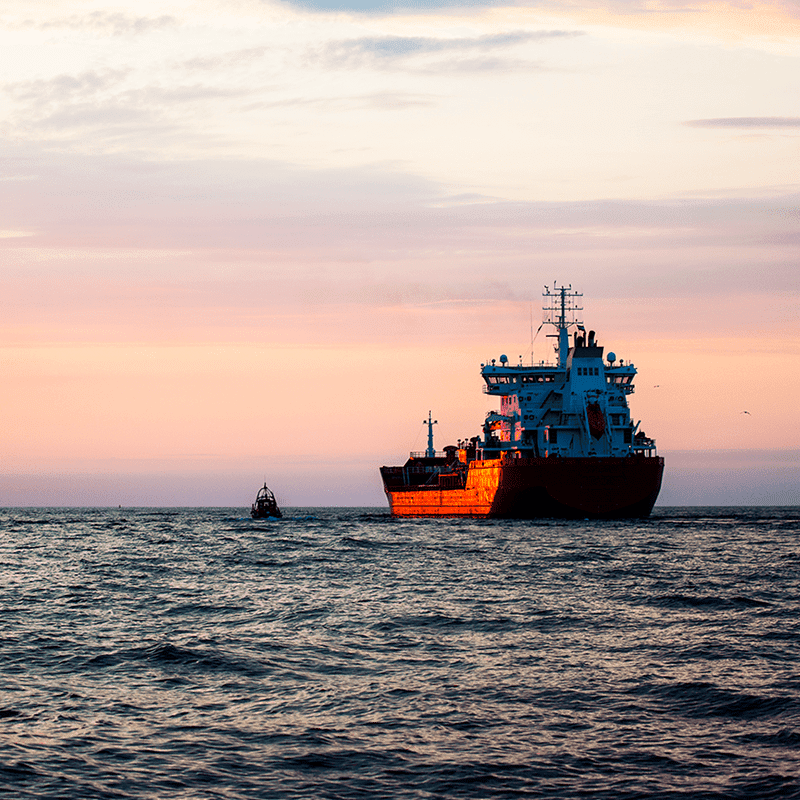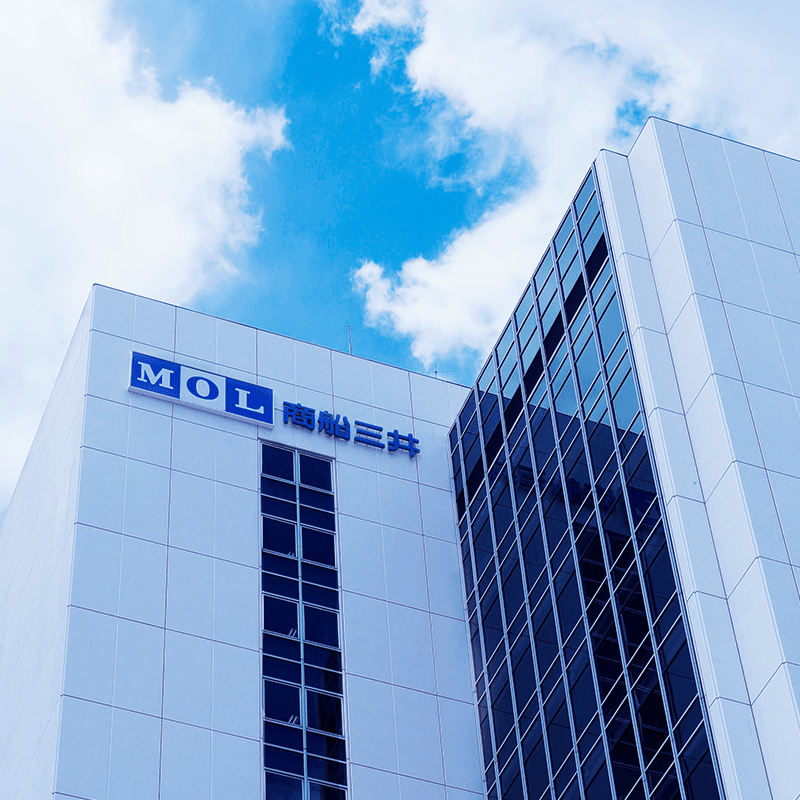BLOG
Maritime DX Revolutionizes the Norms of Operation -The "FOCUS Project" Achieves Both Safe Navigation and Environmental Impact Reduction-
- Eco Friendly
- General Shipping
2024.12.10
At Mitsui O.S.K. Lines (MOL), we are pursuing numerous initiatives with the goal of achieving net-zero emissions across the entire group by 2050. One of the key projects leading this effort is the FOCUS Project, which seeks to balance the promotion of safe navigation and the reduction of environmental impact through a data-driven system. Data is transforming the maritime industry, and this project stands at the forefront of a historical shift in maritime digital transformation (DX).
Key Points
- MOL uses DX, especially FOCUS Project, for safe navigation, environmental reduction.
- FOCUS is a data-driven integrated system collecting real-time ship data.
- Analysis reveals "real-sea performance", enabling optimal, efficient operations.
- Fuel efficiency target was met early by collecting, analyzing data.
- The system aims for further advancement using AI utilization.
A Large-scale Data-driven Integrated Platform
-
MOL is advancing a wide variety of initiatives with the goal of "achieving net-zero emissions across the entire group by 2050". When viewed holistically, these efforts resemble tributaries converging into the mainstream of "net-zero".
-
Among the various strategies at play, there are five key actions aimed at achieving mid to long-term goals: 1. the introduction of clean energy, 2. the adoption of advanced energy-saving technologies, 3. the enhancement of operational efficiency, 4. the creation of business models that support net-zero, and 5. the expansion of low-carbon and decarbonization efforts across the entire group.

Diagram of “5 actions aimed at achieving mid to long-term goals”
from MOL Group Environmental Vision 2.2
- Among these, action number 3. operational efficiency is at the heart of a major initiative known as the "DarWIN Project", which stands for "Digital Approach to Reduce GHG With Integrated Network". The project takes inspiration from Darwin's theory of evolution, signifying a continuous evolution of environmental improvement efforts, adapting to changing conditions over time.
-

"DarWIN Project" logo and specific initiatives
- The operational efficiency initiative, i.e. the DarWIN Project, can be broken down into three key components: 1. a "system" that visualizes vast amounts of data from operating vessels, 2. a "framework" that ensures resources are in place to analyze the data and implement efficient operations, and 3. a "process" that facilitates the sharing of information and the execution of actions that ensure vessels follow the optimal routes and operate at the ideal output. The "FOCUS Project" introduced in this article falls under the domain of the first component, the "system".
Mr. Yoshiki Komi, the team leader of MOL's Maritime DX Co-Creation Unit/Maritime Data Integration Team (MINTG), explains, "The FOCUS Project is a system development initiative aimed at utilizing all operational data from every ship that MOL operates in real-world conditions to enhance safe navigation and reduce environmental impact." FOCUS stands for "Fleet Optimal Control Unified System", signifying the aim to achieve optimal operations through an integrated, data-driven system.
-

3 initiatives for operational efficiency

- Mitsui O.S.K. Lines, Maritime DX Co-Creation Unit/Maritime Data Integration Team, Mr. Yoshiki Komi
5 Categories, 40 Functions, and 10,000 Types of Data to "Visualize the Current State of the Ship"
FOCUS collects all types of data related to ship operations in real time via sensors and other devices, then transmits the data via satellite to be shared with onshore operations managers. While the system was first launched in 2018, "PHASE 2" was released in October 2022, expanding its coverage to include not only MOL's owned ships but also chartered vessels, encompassing about 500 ships in total.
Mr. Soma Miura, who is in charge of system development at MINTG, explains, "A cargo ship can be up to 300m (approx. 984 ft) long, and it's akin to having an entire factory or building on the move." Ships have incredibly complex systems, and are constantly navigating ever-changing sea conditions, generating an enormous amount of data.
PHASE 2 collects data across five categories:
1. navigation information viewing
2. performance analysis
3. onboard equipment monitoring
4. fuel-saving measures
5. other auxiliary functions (see overview table)
These are realized through 40 functions, and approximately 10,000 data points per vessel are collected at intervals as short as one minute.
One example is the "Noon Report", a daily report prepared at noon summarizing changes in the ship's position, speed, fuel consumption and propeller rotation from noon the previous day to noon on the current day. In FOCUS, this data is automatically collected and stored in onshore servers.
The system also includes a function to monitor the status of onboard equipment such as engines and generators, with a feature that notifies when alarms are triggered on the ship. Additionally, it has the capability to monitor and evaluate whether energy-saving devices introduced to reduce fuel consumption are working as intended.

FOCUS conceptual diagram
Determining "Real-Sea Performance"
FOCUS originally began as a joint development project between MOL and Mitsui E&S Shipbuilding to create a system for sharing various data between ships and shore. This collaboration started in 2007, and a decade later, in 2017, a new system with enhanced data collection capabilities was developed by Mitsui E&S Shipbuilding. Building on this system, MOL sought to incorporate the data gathered by shipping companies and further embed the company's operational know-how into the software, leading to the development of the FOCUS platform.
The ability to gather data allows for chronological analysis, examination of correlations, and the sharing of alarms between the ship and onshore operations. "The area we are particularly focused on in system development is performance analysis," explains Mr. Miura.
Ships are constantly influenced by various environmental factors such as changes in wind and ocean currents, the performance of the paint coating the ship's hull, and even the amount of barnacle buildup on the hull, etc. Naturally, the size of the ship and the engine's performance also affect operations. While calm seas may seem ideal for faster speeds, ships often perform better and consume less fuel when there is a tailwind, even on slightly rougher seas.
"With the ability to collect and analyze various types of data, we can now understand a ship’s 'real-sea performance' under a wide range of conditions," says Mr. Miura.

Mitsui O.S.K. Lines, Maritime DX Co-Creation Unit/Maritime Data Integration Team, Mr. Soma Miura
Achieving Fuel Efficiency Improvement Goals
Two Years Ahead of Schedule
Expectations for FOCUS are high, both on the ship and onshore. Sharing data to prepare for emergencies and explore more efficient operational methods brings significant benefits to both sides.
For instance, while efforts have long been made in voyage analysis and failure prediction diagnostics, these processes were often reliant on individual skills and analog methods, and the performance of the ship relied heavily on the expertise of the captain and crew. However, by sharing data, collective knowledge can be pooled and fed back to the ship, thereby enhancing the level of safe and environmentally friendly operations.
The operational efficiency initiative, i.e. the DarWIN Project, had set a medium-term goal of "improving fuel efficiency by 5% compared to FY2019 levels, by FY2025". Remarkably, this target was achieved in FY2023, with a fuel efficiency improvement of 7.2%. This success was made possible by collecting, visualizing and analyzing data to find the keys to improvement.

Graph showing the progress of fuel efficiency improvements achieved ahead of schedule
In the past, maintenance was typically conducted at fixed intervals, known as Time-Based Maintenance (TBM). However, by leveraging FOCUS, Condition-Based Maintenance (CBM) is now possible, allowing for preemptive maintenance based on predictive analysis before issues even arise.
The strong demand for FOCUS can also be seen in the user feedback during upgrades. In the 4 years from PHASE 1 in 2018 to the release of PHASE 2 in 2022, over 200 improvements were implemented. These improvements were not rolled out all at once but were developed using an agile methodology, where new software features were immediately deployed for use, allowing for the identification and resolution of any issues through real-time use. The fact that over 200 new features were introduced using the agile method reflects how strongly users responded and were willing to try new functions.
Mr. Miura notes, "FOCUS was developed based on user-specific requests. Previously, about 70% of work hours were spent on creating reports and handling communication during incidents. However, we've received a lot of feedback saying that 'With the introduction of FOCUS, we can now focus on our core improvement tasks.' FOCUS has also been highly effective in ensuring that ships are not isolated."
AI Drives Further Advancement and Growth of the System
Mr. Miura explains, "FOCUS is designed to collect, visualize, and analyze all kinds of data related to ships, creating new insights in the process. It is a vast platform still in its growth phase."
The next challenge for FOCUS is the further advancement of the system, including the utilization of AI. Mr. Ryo Asada, who is also part of MINTG and is responsible for AI-related development in FOCUS, emphasizes, "The key to AI utilization lies in whether it can improve the accuracy of future predictions."
AI's potential will only be fully realized when it evolves from simply monitoring equipment and detecting risks or failures to independently simulating equipment degradation and predicting the timing of failures before they occur. This level of AI utilization relies on constructing a simulation space that replicates the physical world in digital form, known as a "digital twin", which can be used for various purposes such as design modifications, customizations, and failure predictions.
"Of course, AI will also contribute to areas like optimizing fuel consumption and route planning based on weather forecasts, as well as improving cargo management to prevent any damage to transported goods. I believe that various features currently being developed by other groups will eventually be integrated into the FOCUS platform. Having all real-time ship data in our hands, allowing us to balance operational efficiency and environmental contributions, is not a distant future," Mr. Asada states.
 Mitsui O.S.K. Lines, Maritime DX Co-Creation Unit/Maritime Data Integration Team, Mr. Ryo Asada
Mitsui O.S.K. Lines, Maritime DX Co-Creation Unit/Maritime Data Integration Team, Mr. Ryo Asada
MINTG promotes FOCUS as the "new standard in ship operations". Mr. Komi adds, "This is not only because the various advanced functions of FOCUS are fundamentally changing the way operations are conducted, but also because it offers new value in terms of investment in ships."
At the beginning of the article, FOCUS was introduced as one of the "tributaries" supporting the realization of net-zero emissions by 2050 through operational efficiency. However, upon understanding its capabilities, it becomes clear that FOCUS itself is a grand initiative that could transform the entire maritime industry, potentially becoming a new "mainstream" in its own right.

(This article is based on interviews conducted in July 2024.)
Recommended Articles
2022.07.05
- General Shipping
2021.04.13
- Energy
2023.12.19
- General Shipping
2021.08.07
- Eco Friendly
2024.02.06
- General Shipping
- Market Analysis
Latest Articles
2025.11.20
- Energy
- General Shipping
2025.11.11
- General Shipping
2025.10.28
- Energy
- Eco Friendly
- General Shipping
- BLOG
- Maritime DX Revolutionizes the Norms of Operation -The "FOCUS Project" Achieves Both Safe Navigation and Environmental Impact Reduction-









